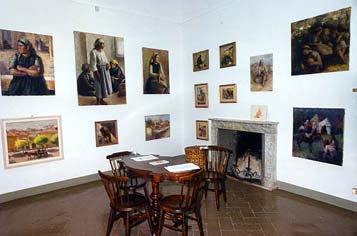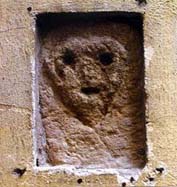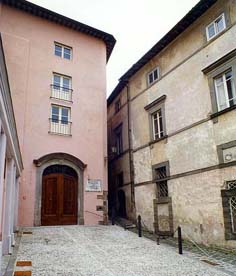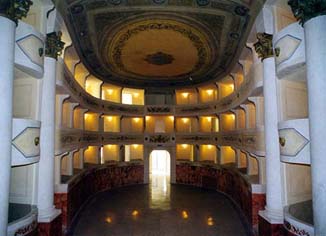|
If
you proceed further along the Via di Mezzo, next to the Palazzo
Mordini, you will find the 17th Century Palazzo Bertacchi where
many famous people have stayed in the past including the Grand Dukes
of Tuscancy, Pietro Leopoldo I (1787) and Leopoldo II (1846). This
palazzo was bought a few decades ago by the Barga painter Bruno
Cordati (1890-1979), one of Italy's greatest twentieth century artists
who, together with Magri and Balduini exhibited at the Biennale
of Venice. Today his works are being critically re-evaluated through
the efforts of his family and of his grandson, Giordano Martinelli,
in particular. Inside the palazzo is a permanent exhibition which
is open to the public in the summer and at other times of the year
on request to the family (tel. 0583/723450 - 050/36105). On the
ground floor of the same building, the Russian artist and engraver
Swietlan Kraczyna, has held for many years a specialised course
in colour printing which attracts artists from all over the world.
Kraczyna was educated in the United States and is an internationally
known artist as well as a recognised and respected figure in Barga.
 |
|
Part of the permanent collection of the works of Bruno
Cordati.
|
In
front of the Palazzo Bertacchi, now Cordati, is another magnificent
17th Century building. This is the palazzo that belonged to the
Pieracchi family, now extinct, whose patrimony was inherited by
the Bertacchi. The palazzo itself then came into the hands of
the Salvi family who were relations of the artist and engraver
Adolfo Balduini, alluded to previously. In fact Balduini lived
in the top floor of this building which he entered from the back
from Via del Pretorio. On either side of the building are the
small passageways, Vicolo Pieracchi and Vicolo del Pretorio, respectively.
Between the latter and the next passageway, Vicolo del Sole, there
is also a very old free-standing building, but of less importance
than the others.
To
the side of the Palazzo Bertacchi-Cordati is a building which used
to belong to the Lugani family, now extinct. In the past this building
was used by the Waldensians for their religious meetings.
 |
|
Small stone head in bas relief on the facade of the Palazzo
Lugani.
|
Further
up on the right, between Vicolo del Sole and Vicolo del Teatro
is another imposing building, now owned by the Stefani family.
This palazzo was built in the second half of the 13th Century
by a family called Bertacchi which became extinct at the end of
the 19th Century, but which does not have any known connection
with the Bertacchis who owned the other buildings already mentioned.
Next
to this palazzo is the 18th Century theatre of the "Differenti",
the name being taken from the name of the Academy which built it.
This theatre is of great interest both artistically and culturally
and has a long and fascinating history. It was first built in wood
in the year 1689, but a little more than a century later it was
considered inadequate for the activities that were to take place
there and so between 1793 and 1795 it was knocked down and rebuilt
in the form that is seen today. The work was financed by members
of the Academy, originally called the "The Indifferenti",
which was founded in 1688, and which later changed its name to the
Academy of the "Differenti". The elaborate and sumptuous
decorations on the inside of the theatre are the work of Francesco
Fontanesi, a painter from Reggio Emilia who, at the time, was the
scenographer for most of the major theatres in Tuscany. Plays and
operas are still performed in the theatre and, in its time, many
a famous personage has walked its boards. On November 26, 1911,
Giovanni Pascoli gave his famous speech in favour of the war with
Libya, entitled "The great proletariat is on the move",
and a stone plaque was erected to record the event.
In
more recent times the theatre fell into disuse for a while because
it did not conform to the strict safety laws for public entertainments.
It was then bought by the town council who, with a reconstruction
project financed principally by European funding, completely renovated
it in line with current law. It is now modernised and outfitted
so that it can be used to its full potential.
The
reorganisation of the space outside the theatre has been the subject
of much criticism. It is, in fact, not only quite different from
the original, but also different from the reorganisation carried
out after the last war when a number of buildings damaged by bombs
were knocked down completely and small green areas were created.
 |
|
The
Theatre of the Differenti.
|
 |
|
The Stalls and Theatre boxes of the Theatre
|
ON 26 NOVEMBER 1911
IN THIS THEATRE
GIOVANNI PASCOLI
GAVE HIS SPEECH ON
"THE
GREAT PROLETARIAT"
LAST LINE OF HIS POEM
THE FIRST WINGBEAT FOR THE NEW GLORIES OF ITALY
The epigraph that records the speech by Pascoli.
next
page
|